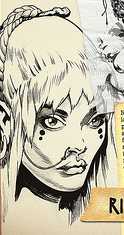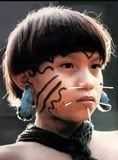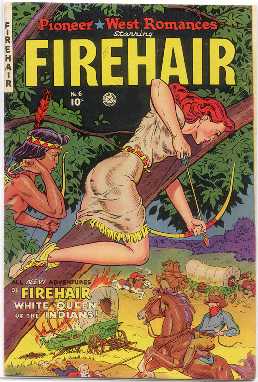Here's a little-known "Native" character who's back in the news:
RimaRima, also known as Rima the Jungle Girl, is a fictional character, a heroine of Edwardian literature who was adapted as the star of short-lived comic book series Rima the Jungle Girl, published by DC Comics in 1974 and 1975.
Like her literary cousins Tarzan and Mowgli, Rima sprang from an Edwardian adventure novel, in her case Green Mansions: A Romance of the Tropical Forest, published in 1904. The Argentine-British writer W. H. Hudson was a naturalist who wrote many classic books about the ecology of South America. Hudson based Rima on a persistent South American legend about a lost tribe of white people who lived in the mountains.
Rima starred in a seven-issue comic book series, DC Comics' Rima the Jungle Girl (May 1974-May 1975), adapted by an uncredited writer and with artwork by penciler-inker Nestor Redondo and covers by Joe Kubert. DC writer-editor Robert Kanigher is the credited writer from issue #5 on.
I read these comics when they came out. I didn't think much about them. They were okay for the same reason Tarzan comics were okay: exotic jungle adventures.
I think RIMA was reasonably sensitive to the indigenous people it portrayed. But you can't get past the central flaw: a white girl who's a better Native than the Natives around her. Whenever there was a problem--avaricious white men who wanted to clearcut the trees, a lost official or missionary, a forest fire--it was Rima to the rescue. The Natives were reactive while she was proactive.
But now the Racialicious blog informs us that Rima is making a comeback:
Race & Comic-Books: Rima The Jungle GirlBy Arturo R. GarcíaDC Comics has begun drumming up buzz for the “First Wave” world--an alternate universe populated by pulp characters like Doc Savage and The Spirit, and pulp incarnations of modern characters like Batman and the first Black Canary.
Monday, though, we got a first look at a potential wrong turn in the new line: creators Brian Azzarello and Rags Morales’ new take on Rima The Jungle Girl.The teaser copy says:
Native South American with unnaturally white hair, late teens, early twenties. Rima has no trace of any European ancestry in her features--she is clearly native, and supernaturally beautiful. (Werner Herzog had a knack for finding this type in his South American films.) And always mysterious. She never speaks, but whistles as if she’s talking to birds--the siren of any story she’s in. She’s not a main character, but a catalyst that drags the real main characters along to their inevitable fates. Perhaps she's not real--but what she does always leads to the protagonist of the story showing what he/she really is all about.García continues:
As it turns out, the character does indeed have its roots in pulp literature, specifically the novel Green Mansions: A Romance Of The Tropical Forest, where Rima--here a white, dark-haired teenage girl--is depicted as a sort-of Noble Lolita Savage: though only 17, the book’s narrator, Abel, falls in love with her because of her “pure” connection with nature--e.g., she can talk to birds. In the book, Rima is the sole survivor of her peaceful (of course!) tribe, which was allegedly based on the legend of a group of white-skinned people who lived in the South American wilderness. Her story ends when--spoiler alert!--she’s burned to death by another (presumably darker-skinned) tribe.
In the comic-book world, though, Rima would go on to live and have adventures, though by this point she was depicted as being an adult with lighter hair than in her prior incarnation.A blogger named BGF (Black...Geek...and Fine With It) puts a
snarky spin on this that begins:
Rima the Jungle Girl has no trace of any European ancestry in her features--she is clearly native no really don't go by the illustration, trust the copy over the illustration, or any experience you may have had talking to native persons in addition to whatever you think you saw in National Geographic because she is supernaturally beautiful as all native persons are, just tweaked a little bit so that she conforms to universally acknowledged standards of beauty which is necessary for the market and the wet dreams of our target audience, we went through the same effort that Werner did to find an native woman like this among all of the regular ones well except for the part where we just sat on our asses and drew it so anyway that's one of the reasons she is also always mysterious because that's why native persons keep showing up in National Geographic when you think about it, and we're just reflecting that in our work.Comment: The original Rima was racist and stereotypical in almost every way and the new version apparently will be the same.
European features...a long, slender, European body type...dazzling white skin...long, luxurious white hair...there's absolutely nothing Native about this "Native" girl's appearance. This concept is as backward as the "white Indian" Firehair from the 1950s. The implication is that readers can't deal with a brown-skinned protagonist. The protagonist has to be white like Tarzan, Mowgli, and every other hero in pre-modern literature.
Judging by the picture, the only thing Azzarello and Morales have done to make Rima Native is add a couple dots under her eyes and a nose chain. Otherwise her big soulful eyes and pouty Botoxed lips are pure Anglo-Saxon. This girl would be at home at any Goth party in a major US city.
How insulting is it to claim that the only difference between a white and Native person is the skin color? That an albino Native or African person is essentially indistinguishable from a white person? Pretty damn insulting.

 A nearly-naked Native girl-woman as a sexual object for white-male readers to drool over. That trend began with Pocahontas and continued with countless scantily-clad Indian princesses.
A nearly-naked Native girl-woman as a sexual object for white-male readers to drool over. That trend began with Pocahontas and continued with countless scantily-clad Indian princesses.
Nor were things much different in other areas of racially-tinged literature. You might meet an exotic Asian or Arab princess because their "olive" skins and long, luxurious black hair weren't too "unnatural." But you almost always found a white woman in place of anyone who might be too brown or black--i.e., too African or indigenous. For instance, Ayesha or Sheena the Jungle Queen. Apparently nothing has changed since then.Rima is the catalyst for other people's adventures rather than the star of her own adventures. Right, because readers can identify only with non-Native characters who enter the exotic jungle and are changed by it. Who cares what the Native characters are thinking or feeling, because they aren't us? They're less human than we are--closer to nature, more a part of the animal kingdom than anything else.Rima can't talk because that would make her a real person and not a white fetish substitute for Native people. I wouldn't be surprised if some Amazon tribes had bird whistles as signals, but as their primary or sole language? I don't think so.ConclusionReally, what's the justification for perpetuating the "white Indian" stereotype? "They did it a century ago, so it's okay to do it now, because we're just reiterating what they did"? Wrong.
Would you use that excuse to do an Uncle Tom, Aunt Jemima, or Amos 'n' Andy comic book? No? Then what's your excuse for this comic? There is no excuse that I can see.
Here's a deep thought. How about updating Rima by making her an actual Native? You know, a brown-skinned Amazon Indian who's five feet tall with a bowl haircut, some uncomfortable piercings or tattoos, and a child on her hip? Or would that be
too exotic for Eurocentric audiences?
If you want to reference the old Rima, say the new Rima is her great-granddaughter. She's interested in white people because one of her eight great-grandparents was a strange white woman. But this Rima is wholly Native except for a bit of non-Native blood.
For more on the subject, see
Comic Books Featuring Indians.
Below: One of countless "white Indians" readers could identify with because she wasn't a brown-skinned savage.







1 comment:
This is an excellent post, and I will be referring (not linking, no blog) several people to it!
Nor were things much different in other areas of racially-tinged literature. You might meet an exotic Asian or Arab princess because their "olive" skins and long, luxurious black hair weren't too "unnatural." But you almost always found a white woman in place of anyone who might be too brown or black--i.e., too African or indigenous. For instance, Ayesha or Sheena the Jungle Queen. Apparently nothing has changed since then.
YES x4378295478, and a truth rarely talked about.
Post a Comment